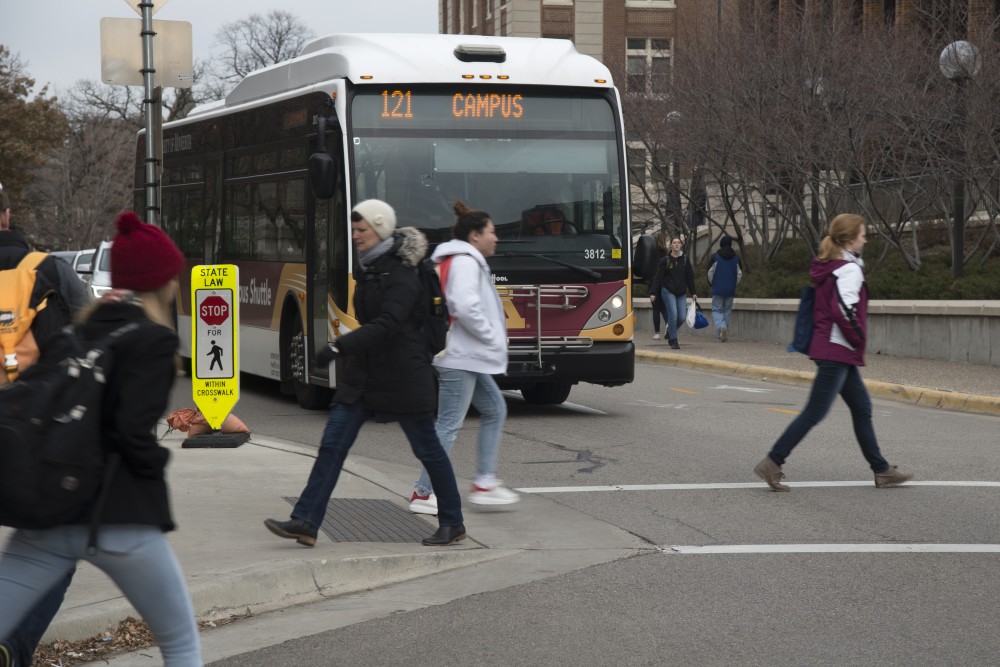A study presented to the Minneapolis Transportation and Public Works committee Tuesday identified hot-spots and trends for pedestrian crashes in the city.
Data in the study examined where pedestrian crashes in the city occur, as well as the causes of the crashes. The City will use the data toward its Vision Zero goal, which aims to reduce fatalities and serious injuries from crashes on city streets.
“With Vision Zero, the goal… is to eliminate all severe and fatality crashes by the year 2027,” said Steve Mosing, traffic operations engineer for the Minneapolis Department of Public Works. “We wanted to educate ourselves on how and why pedestrian crashes are occurring, so this report will be relied upon to work toward the Vision Zero goals and also mitigating crashes and reducing crashes.”
The study found 80 percent of all pedestrian crashes happen on 10 percent of the city’s streets. Around the University, pedestrian crash corridors include University Avenue Southeast and 4th Street Southeast.
Seventy four percent of major crashes occurred on less than 5 percent of streets. The study found 4th Street Southeast was among the streets with the most collisions, in what the study defines as the “high injury network.”
“We have isolated accidents involving pedestrians [around campus],” University of Minnesota Police Department Lieutenant Chuck Miner said. “We typically see that with jaywalking issues, both with pedestrians and bikes, and not following the lights.”
The study also found that University Avenue and 4th Street Southeast have more cars, buses, bikes and pedestrians. These areas tend to also have greater crash density.
“There’s way more of a volume of pedestrians on intersections around campus,” Miner said.
University spokesperson Lacey Nygard said the University of Minnesota urges pedestrians and bicyclists on and around campus to abide to crossing signals, crosswalks and bike lanes.
“Safety is a high priority at the University of Minnesota. With a growing density in neighborhoods surrounding campus, we will continue to work with the City of Minneapolis to examine ways to make the area safer for pedestrians,” Nygard said in an email.
Leading pedestrian intervals give pedestrians a WALK signal before the parallel lights turn green. The study analyzed current LPIs and their effectiveness in reducing pedestrian crashes.
LPIs currently exist at the intersection of 4th Street Southeast and 15th Avenue Southeast, and 4th Street Southeast and 14th Avenue Southeast. According to the study, no pedestrian crashes have occurred at 4th Street Southeast and 15th Avenue Southeast since the installation of LPIs in 2014.
At 4th Street Southeast and 14th Avenue Southeast, pedestrian crashes have not seen any significant decrease since LPIs were introduced.
“Leading pedestrian intervals seem to have a positive impact at some intersections and a not-so-positive impact at other intersections,” Steve Mosing said. “The data’s still real young with that, and we need to have more data as these systems exist out there to draw any type of conclusion.”
A majority of pedestrian crashes occur at intersections, with over two-thirds occurring at traffic signals. Mosing said the study will help the city focus attention on the most problematic crash areas.
“A nice reason for this report is that it really did focus into areas. Minneapolis has a lot of roadways and a lot of intersections,” he said. “There’s over 7,500 intersections in this city, and to provide a focus for us to prioritize our potential enhancements in the future really helps us.”

















